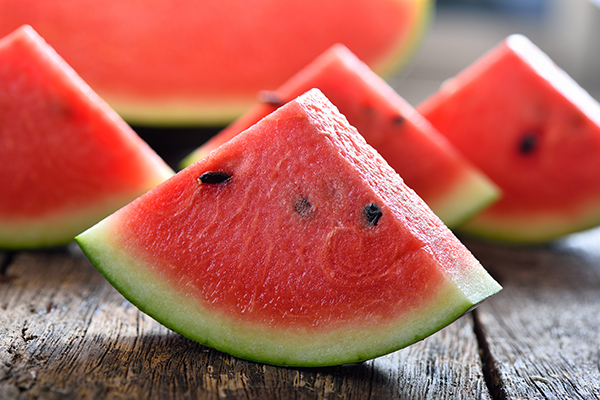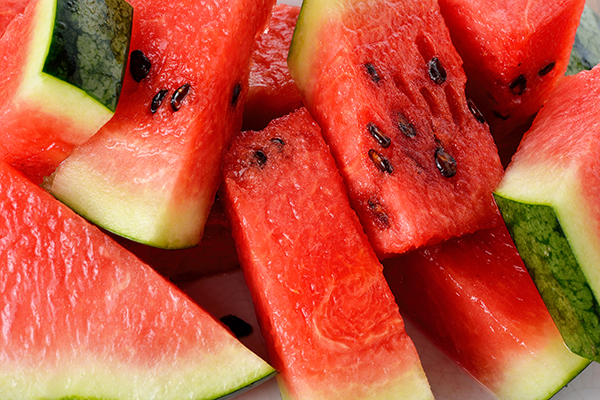Watermelon properties
Watermelon is one of the healthiest and most refreshing fruits to combat the heat.
fresh food
Share

Watermelon comes from Egypt and was first grown on the banks of the Nile. Later, the Israelites extended its cultivation to Mediterranean countries and nowadays it has become a typical fruit of warm and temperate climates. The main producing countries are: Spain, Italy, Turkey, Greece, China and Japan.
It is characterised by its smooth, hard skin, with a 2 - 4 cm thickness which is green, light green or yellowy green. Its flesh can be red, pink or yellow, and it usually has shiny black, brown or white seeds.
It is one of the largest fruits in the market and can weigh as much as 10-15 kilograms, although the most common ones range between 3 and 8 kilograms. Production in Spain takes place between the months of June and September.
Most popular and consumed varieties
Nowadays there are more than fifty varieties, classified according to their shape, colour of the flesh and skin, weight, ripening period, etc.
With seeds:
Sugar Baby (Italy, Greece and Spain): Its skin is a dark green colour and its flesh is slightly pink. It contains a lot of water.
Crimson Sweet (Almería): It is a sweet variety, with quite dark skin and an intense red flesh.
Resistent (Valencia): Similar to the previous one, it is resistant and quite sweet.
Without seeds
Reina de Corazones (Almería): ): Its skin is an intense and shiny light green colour and it has dark green stripes. It is a very sweet variety, with an intense red flesh and with lots of water.
Fashion (Mediterranean coast): It looks a lot like the traditional watermelon because of its dark green skin, its slightly pink flesh and good tasted and conservation.

Nutritional composition
It is a perfect fruit for summer because, having a 93% water content, it is very hydrating. It also contains lycopene, the substance which gives its flesh the pink colour.
It is a fruit with very few carbohydrates, so it can be eaten by diabetics. In addition, it hardly contains any fats, it has a high water content and is very satiating.

Uses of watermelon
Watermelon is a very versatile fruit and combines perfectly with many foods. It can be eaten on its own or in a fruit salad, either before or after meals, and is also interesting to use in salads, sorbets, juices or ice creams.
The seeds can be eaten, in fact, in many Asian countries they are eaten as an aperitif, both toasted and fried, and there are even places where they are used to make bread.
Advice for buying and conservation
To know if a watermelon is ripe, check if it has a yellow creamy stain on its skin, a sign indicating the area of contact of the fruit with the floor while it was ripening. When tapping it with your fingers or the palm of your hand, it should sound “hollow” and with dark green watermelons, you should be able to easily scratch the skin with your nail.
You can often find half watermelons in the supermarket, perfect for smaller families. To choose the best, check that the flesh is firm and contains quite a lot of water.
The whole watermelon, thanks to its thick skin can be conserved perfectly for two or three weeks at room temperature, as long as it is stored in a cool dry place.
Once cut, it must be eaten quickly so it doesn’t lose its flavour and properties. It is worth keeping in the fridge, but always in the least cold part because it is sensitive to low temperatures. It is recommended not to store it below 7-10ºC.

Watermelon slush
Ingredients:
-Half a watermelon without its skin and without seeds
-4 tablespoons of water
-6 drops of sweetener or 2 tablespoons of sugar
Preparation:
Cut the flesh of the watermelon into chunks and place them into the glass of a blender. Mix with the 4 tablespoons of water and sweetener or sugar, whichever you prefer. Mix it up, pour it into a container and place it into the freezer, stirring it occasionally. Take it out of the freezer a little while before eating and serve cold. You can add a sprig of mint.






